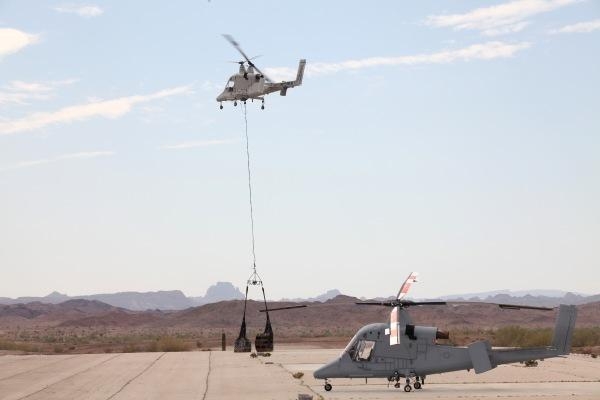Thu, Sep 08, 2011
Lockheed Martin/KAMAN Demonstrate Autonomous Resupply
Capabilities
A five-day Quick Reaction Assessment (QRA) for the U.S.
Navy’s Cargo Unmanned Aircraft Systems (UAS) program has been
successfully completed by the Lockheed Martin-led unmanned K-MAX
team.

“The autonomous flying K-MAX is designed to resupply
Marines on the battlefield and in remote locations,” said
Roger Il Grande, director of Airborne Systems at Lockheed Martin
Mission Systems & Sensors. “Through various scenarios
during QRA, the unmanned K-MAX UAS performed extremely well,
exceeding the cargo delivery objectives of the
assessment.”
The U.S. Navy awarded Lockheed Martin a $45.8 million contract
in December 2010 for unmanned K-MAX helicopters to perform in a
U.S. Marine Corps evaluation of unmanned cargo resupply. The Navy
intends to field a Cargo UAS this fall for a six-month deployment
to augment Marine Corps ground and air logistics operations in
Afghanistan. "The Quick Reaction Assessment proved sustainment of a
cargo-carrying capability in an operational environment” said
Capt. Patrick Smith, Cargo UAS program manager at the Navy’s
Patuxent River, Md., facility. "We look forward to deploying a
capability that will supplement rotary wing assets and reduce
Marine Corps exposure to improvised explosive devices in
theater."
A formal report will be released by Commander Operational Test
and Evaluation Force (COMOPTEVFOR) 30 days post completion of QRA.
Results will be reviewed by Navy and Marine Corps leadership to
determine the system’s suitability for deployment.
In July, the unmanned K-MAX successfully completed
Electromagnetic Environmental Effects (E3) testing at Pax River.
The purpose of the E3 testing was to measure and provide results
regarding the aircraft's electromagnetic susceptibility to certain
frequencies, which can affect flight-critical and other systems on
the aircraft. “Since partnering in 2007, Lockheed Martin and
Kaman Aerospace have successfully transformed Kaman’s proven
K-MAX power-lift manned helicopter into a UAS capable of autonomous
or remote controlled cargo delivery,” said Terry Fogarty,
general manager, UAS Product Group at Kaman Aerospace.
More News
Aero Linx: The American Society of Aerospace Medicine Specialists (ASAMS) The Society is a non-profit organization created to serve as a voice for and represent the professional ne>[...]
Class C Service This service provides, in addition to basic radar service, approved separation between IFR and VFR aircraft, and sequencing of VFR aircraft, and sequencing of VFR a>[...]
Have A Story That NEEDS To Be Featured On Aero-News? Here’s How To Submit A Story To Our Team Some of the greatest new stories ANN has ever covered have been submitted by our>[...]
Also: ERAU Uses UAVs, P550 Group 2 UAS, Starship’s Florida Launches, NASA Missions Chopped The Air Force has put out a call to commission a one-to-one copy of the Iranian-des>[...]
Classic Klyde Morris From 11.07.16 (and Remembering Bob...) FMI: www.klydemorris.com>[...]
 ANN's Daily Aero-Linx (08.27.25)
ANN's Daily Aero-Linx (08.27.25) ANN's Daily Aero-Term (08.27.25): Class C Service
ANN's Daily Aero-Term (08.27.25): Class C Service ANN FAQ: Submit a News Story!
ANN FAQ: Submit a News Story! Airborne-NextGen 08.26.25: Iran UAV Knockoffs, X-37B Spaceplane, Army Training
Airborne-NextGen 08.26.25: Iran UAV Knockoffs, X-37B Spaceplane, Army Training Classic Klyde Morris (08.25.25)
Classic Klyde Morris (08.25.25)



